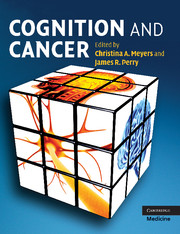Book contents
- Frontmatter
- Contents
- List of contributors
- Preface
- Section 1 Cognition and the brain: measurement, tools, and interpretation
- Section 2 Effects of cancer and cancer treatment on cognition
- 7 Biological bases of radiation injury to the brain
- 8 Cognitive dysfunction related to chemotherapy and biological response modifiers
- 9 Effect of hormones and hormonal treatment on cognition
- 10 Low-grade gliomas
- 11 High-grade gliomas
- 12 Brain metastases
- 13 Primary central nervous system lymphoma
- 14 Childhood brain tumors
- 15 Neurofibromatosis
- 16 Hematological malignancies
- 17 Paraneoplastic disorders
- 18 Symptomatic therapies and supportive care issues
- 19 Animal models and cancer-related symptoms
- Section 3 Interventions and implications for clinical trials
- Index
- Plate section
- References
7 - Biological bases of radiation injury to the brain
Published online by Cambridge University Press: 13 August 2009
- Frontmatter
- Contents
- List of contributors
- Preface
- Section 1 Cognition and the brain: measurement, tools, and interpretation
- Section 2 Effects of cancer and cancer treatment on cognition
- 7 Biological bases of radiation injury to the brain
- 8 Cognitive dysfunction related to chemotherapy and biological response modifiers
- 9 Effect of hormones and hormonal treatment on cognition
- 10 Low-grade gliomas
- 11 High-grade gliomas
- 12 Brain metastases
- 13 Primary central nervous system lymphoma
- 14 Childhood brain tumors
- 15 Neurofibromatosis
- 16 Hematological malignancies
- 17 Paraneoplastic disorders
- 18 Symptomatic therapies and supportive care issues
- 19 Animal models and cancer-related symptoms
- Section 3 Interventions and implications for clinical trials
- Index
- Plate section
- References
Summary
Introduction
Neoplasms of the central nervous system (CNS) are a pathologically diverse group of benign and malignant tumors for which a variety of management strategies, including observation, surgery, radiation therapy, and/or chemotherapy, are employed. Regardless of the type of CNS tumor treated, what usually limits the dose of radiation that can be utilized, and therefore what typically determines the local control and cure rate of that tumor, are the tolerance doses of the adjacent or underlying normal tissues in and around the CNS. This chapter will outline the biological principles of CNS radiation tolerance and radiation-induced CNS injury, with an emphasis on the brain.
Pathogenesis of radiation-induced CNS injury
Classical model of parenchymal or vascular target cells
Vascular abnormalities and demyelination are the predominant histological changes seen in radiation-induced CNS injury. Classically, late delayed injury was viewed as due solely to a reduction in the number of surviving clonogens of either parenchymal, i.e., oligodendrocyte (Van den Maazen et al., 1993), or vascular, i.e., endothelial (Calvo et al., 1988), target cell populations leading to white matter necrosis.
Vascular hypothesis
Proponents of the vascular hypothesis argue that vascular damage leads to ischemia with secondary white matter necrosis. In support of this hypothesis is the large amount of data describing radiation-induced vascular changes including blood vessel (primarily arterial) wall thickening, vessel dilation, and endothelial cell nuclear enlargement (Calvo et al., 1988; Reinhold et al., 1990; Schultheiss & Stephens, 1992).
- Type
- Chapter
- Information
- Cognition and Cancer , pp. 83 - 96Publisher: Cambridge University PressPrint publication year: 2008
References
- 6
- Cited by

